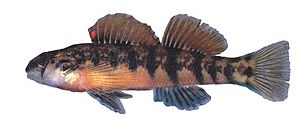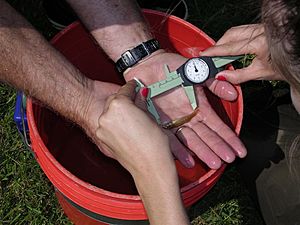Cherokee darter facts for kids
Quick facts for kids Cherokee darter |
|
|---|---|
 |
|
| Conservation status | |
| Scientific classification |
The Cherokee darter (Etheostoma scotti) is a special and rare type of freshwater fish. It's a small fish that belongs to the same family as perches. You can only find it in Georgia, in the United States. Specifically, it lives in the Etowah River system. This fish likes creeks with rocky bottoms and clear water. It's currently considered an endangered animal, meaning it's at risk of disappearing forever.
Contents
What Does the Cherokee Darter Look Like?
The Cherokee darter is usually whitish or yellowish. It has cool olive green and black spots on its sides. These spots can get bigger when it's time for them to breed. On its back, it has eight dark, saddle-like stripes. The male fish can grow to be about 5 centimeters long. That's about the length of your pinky finger!
How Do Cherokee Darters Reproduce?
Cherokee darters lay their eggs from March to June. The females usually place their eggs in gravel. Sometimes, they might use bedrock or pieces of wood. These fish become old enough to have babies when they are one year old. They usually don't live longer than two years.
Where Do Cherokee Darters Live?
The Cherokee darter is found only in Georgia, USA. It lives in the Etowah River system. It prefers creeks with rocky bottoms. It also likes clear parts of the stream with very little silt.
Specific Locations in Georgia
You can find this fish in several smaller streams that flow into the Etowah River. However, not many of these groups of fish are very large or healthy. The bigger groups of Cherokee darters live in the northern streams above Lake Allatoona. This large lake is in the middle of where the fish usually live. It splits their home into two parts, which makes it harder for the different groups of fish to connect.
Why Is the Cherokee Darter Endangered?
This fish was officially named a new species in 1995. But it was listed as a threatened species in the United States even earlier, in 1994. The number of Cherokee darters is going down. This is because they are losing their homes.
Threats to Their Habitat
Their habitat is being harmed by several things:
- Stream changes: Building dams or changing how streams flow.
- Siltation: Too much dirt and mud getting into the water. This covers the rocky bottoms they need.
- Pollution: Harmful chemicals or trash getting into the water.
Because of these problems, the International Union for the Conservation of Nature says the Cherokee darter is an endangered animal. This means it is at a very high risk of becoming extinct in the wild.
See also
 In Spanish: Etheostoma scotti para niños
In Spanish: Etheostoma scotti para niños



